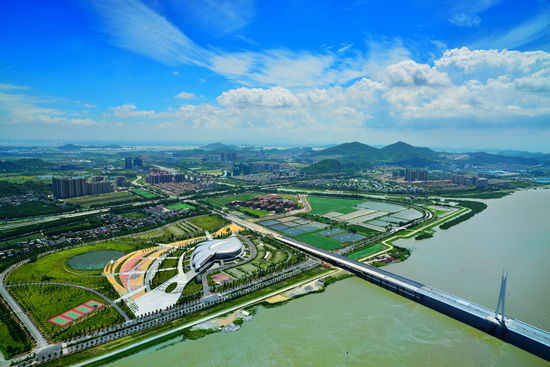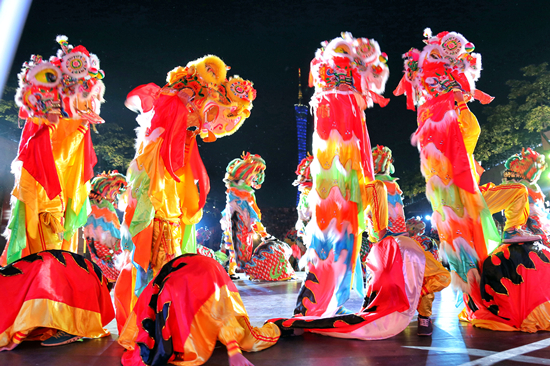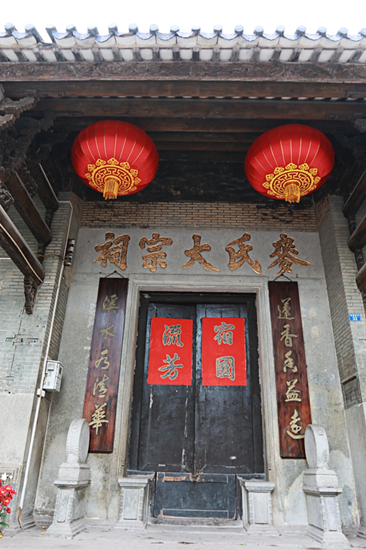Huangge Town
Huangge is full of a cultural atmosphere with Kylin Dancing, ancient temples and ancestral halls.
Huangge is decorated with green lights because of its ten-mile stream sparkling with emerald water and lilies.
Huangge is attractive with red litchi set on the green mountain.
What are the best stories about Huangge?

The aerial view of Huangge Town.[Photo/gznsnews.com.cn]
Kylin Dance
Huangge’s old name, Fenghuang Pavilion, also known as Huangqijiao, was given to a small hill and phoenix pavilion in the village. In the Song Dynasty (960-1279), the pavilion was referred to as Huangge, and today the town area is more than 70 square kilometers.

Huangge Kylin Dance [Photo/gznsnews.com.cn]
Huangge Kylin Dance, or Unicorn Dance, which originated from ancient Kylin totem worship, is part of the art culture that Huangge people have passed down from generation to generation. It inherits the traditional Chinese Kylin spirit and embodies the Chinese nation's persistent pursuit of benevolence, righteousness, courtesy, wisdom and trust.
The dance has been popular in Huangge for more than 100 years. It is a combination of Guangdong music and Southern Wushu. Twenty-nine-year-old dance coach Zhang Zikang has been learning Chinese Wushu since he was a little boy. He and his team members creatively adapted Kylin dance and won a cultural gold medal, updating the dance to modern times.
In Huangge, not only did men love to dance like a unicorn, but women and children did as well. The Women's Kylin Team of Dongli Village was established in 2014. It is the earliest Guangzhou-based Kylin team.
Kylin represents the spirit of the people of Huangge Town, including the beautiful wishes of its residents.
Lianxi Village
Lianxi Village, located in the central area of Huangge Town, is one of the town' s four big villages. Its biggest feature is two large lotus ponds.
The lotus leaves shine in a green light. The wind pierces the long pavilion and then turns to play with some weeping willows. You can stand comfortably in the pavilion and enjoy the feeling of the wind and the play of lights.
The Mai's ancestral hall was built in the Yuan Dynasty (1271-1368). Its vivid stone and wood carvings are an exquisite part of the largest ancient ancestral temple in Nansha.
Tianhou Ancient Temple
When it comes to characteristic buildings, one of the most prominent is the Tianhou artillery building.
Built in 1919, it is a brick wall with granite legs. The entire building is sturdy and beautiful, full of history and a quaint atmosphere.
The Huangge Tianhou Ancient Temple, built in 1927, was larger than the current Nansha Tianhou Temple. In the 1960s and 1970s, it was demolished. The current one was later built by the villagers.

Ancestral hall in Huangge Town[Photo/gznsnews.com]
Litchi
Huangge Town is rich in litchi, with an area of about 4,800 mu. It mainly distributed in the high, warm area, where it is irrigated by mountain water. In the unique natural environment, this year's Huangge Town litchi production exceeded two million jin (one jin is about 0.5 kgs).
Forest town
In the future, Huangge will be divided into three ecological functional areas to create“forest towns”, namely an eastern wetland ecological sightseeing area, a western folk culture and tourism area, and a southern forest ecological experience area. In addition, total investment in the construction of six major sectors such as a green ecological water network has reached 31.547 million yuan ($ 4.71 million).
All rights reserved. Presented by China Daily




